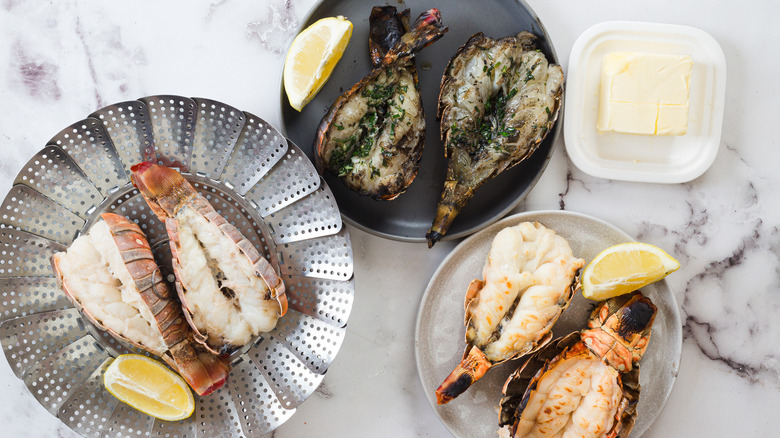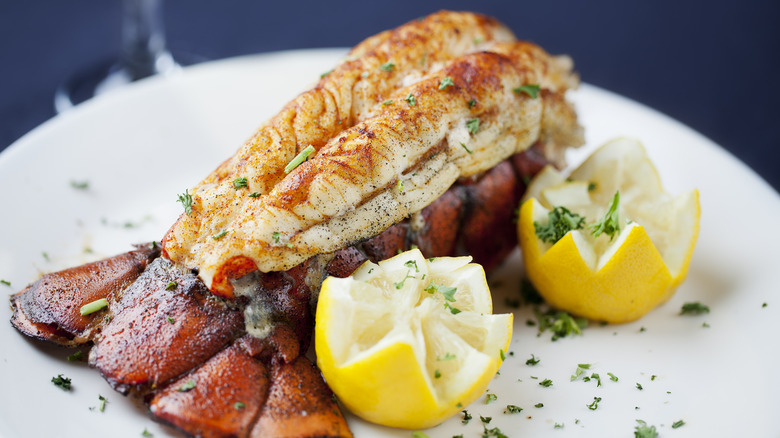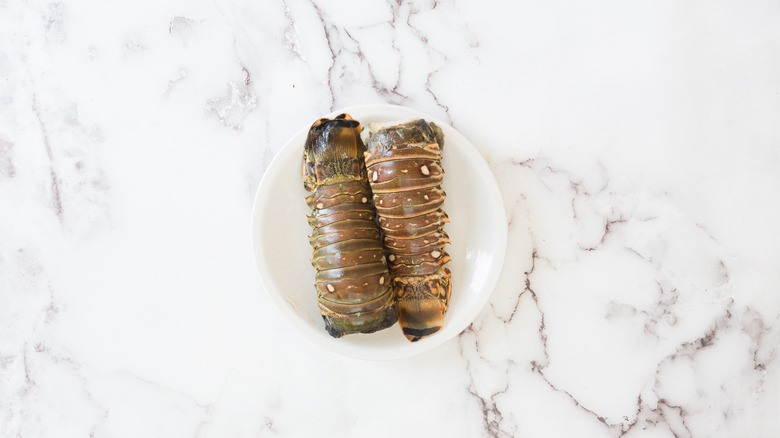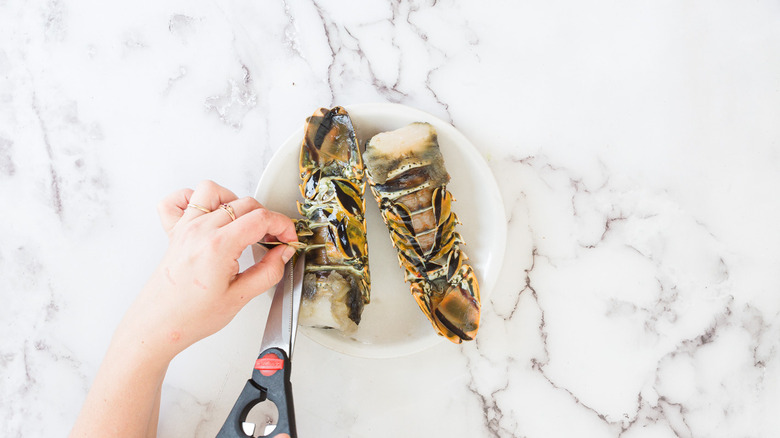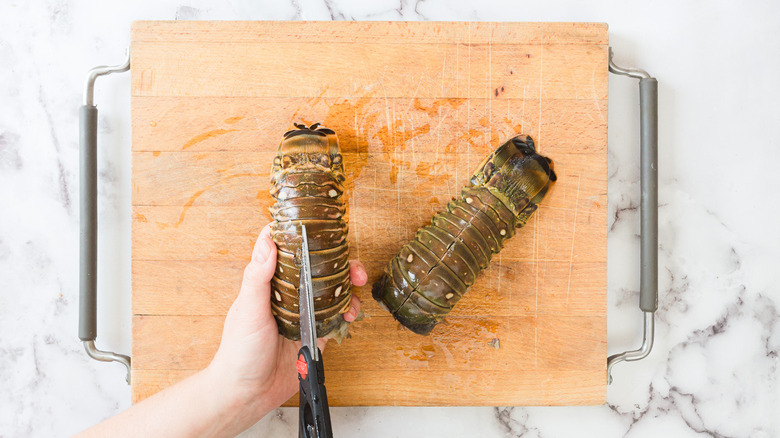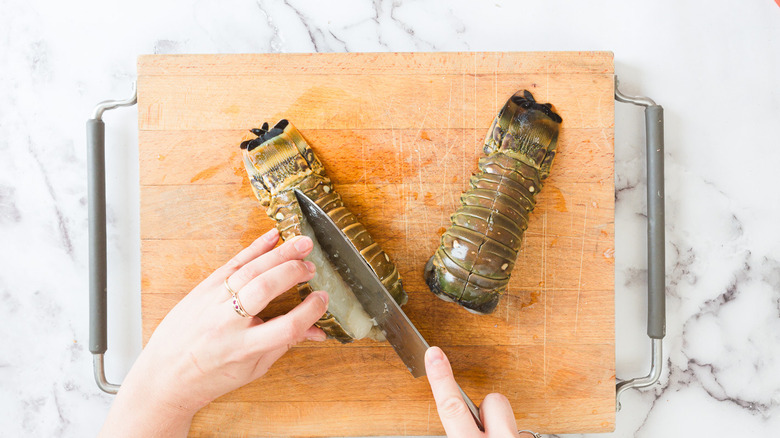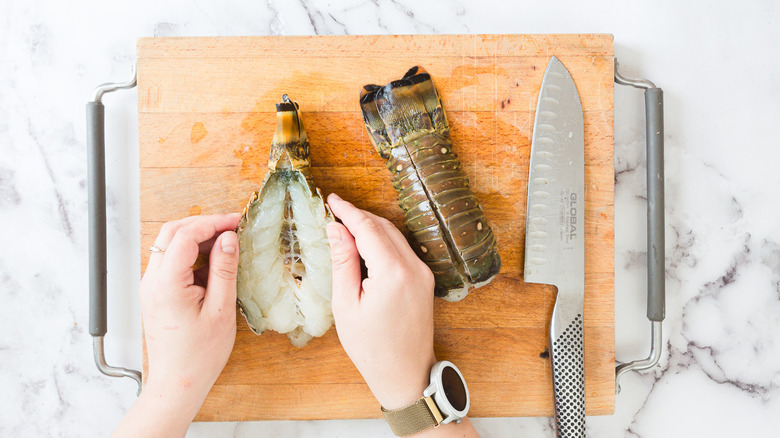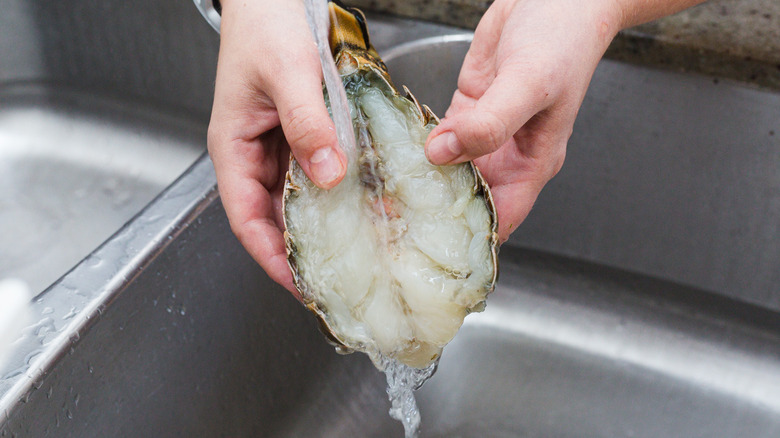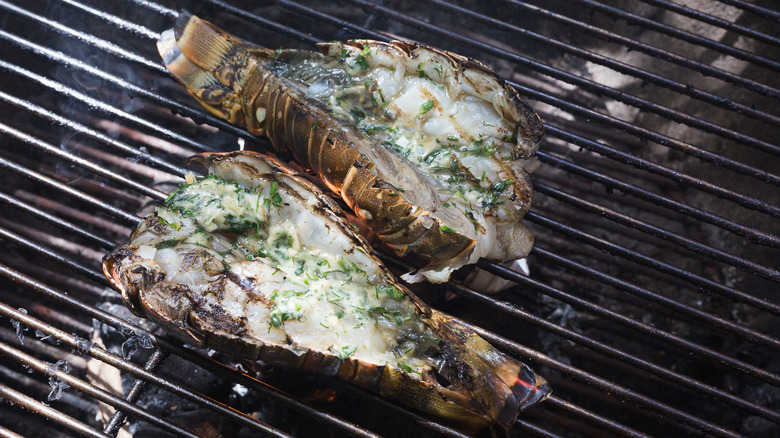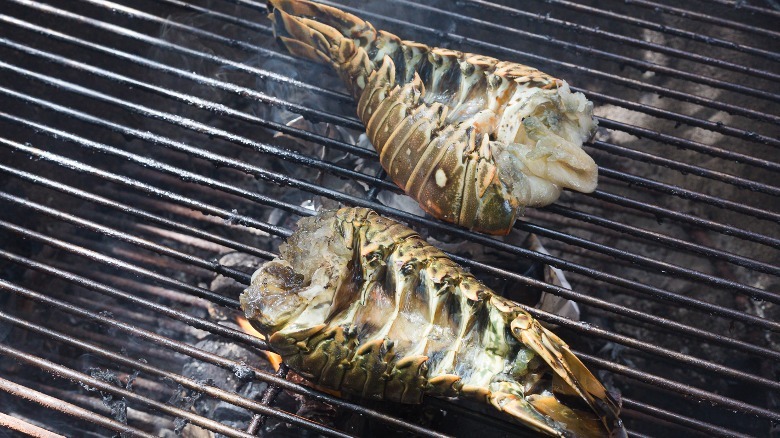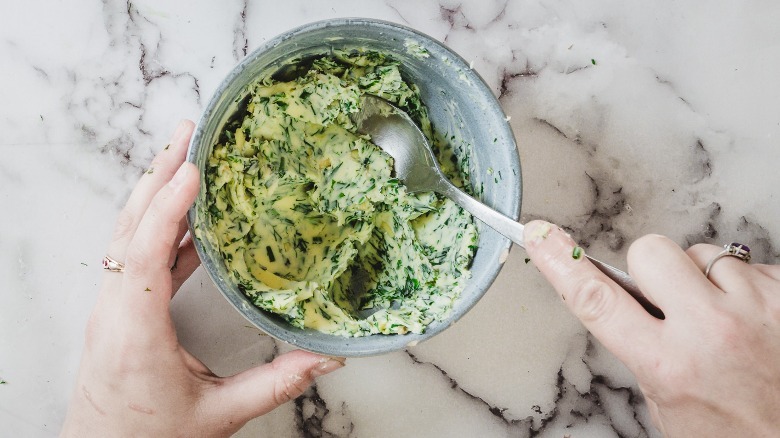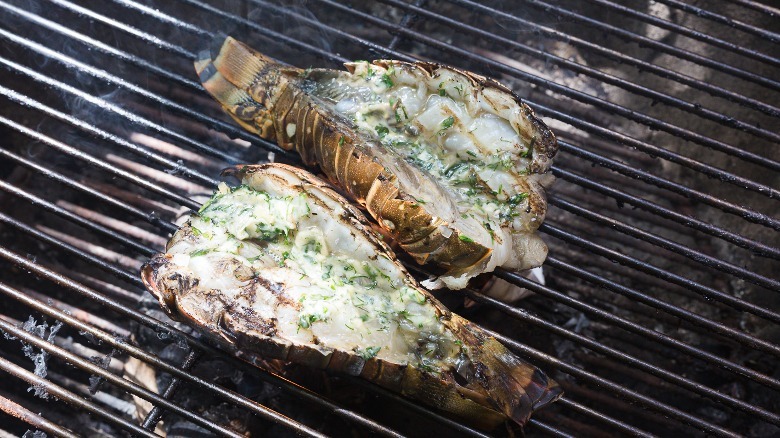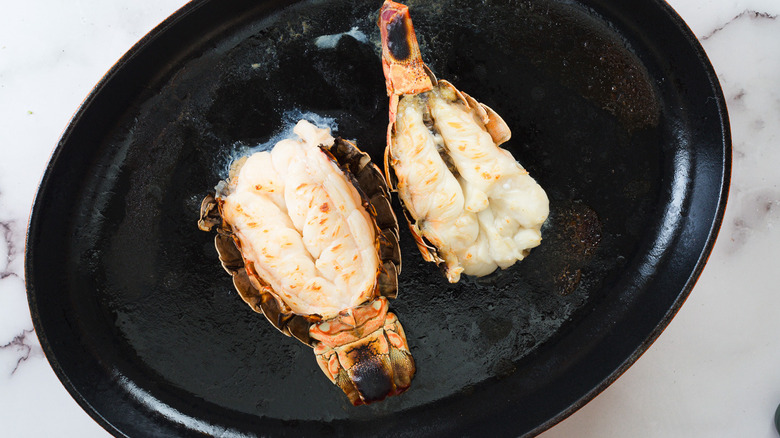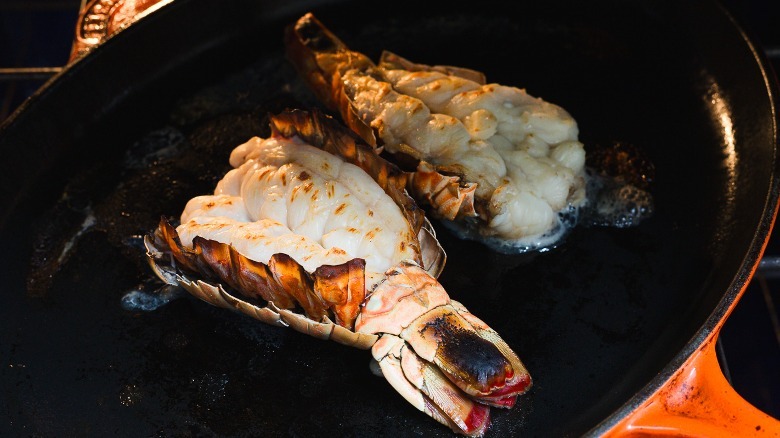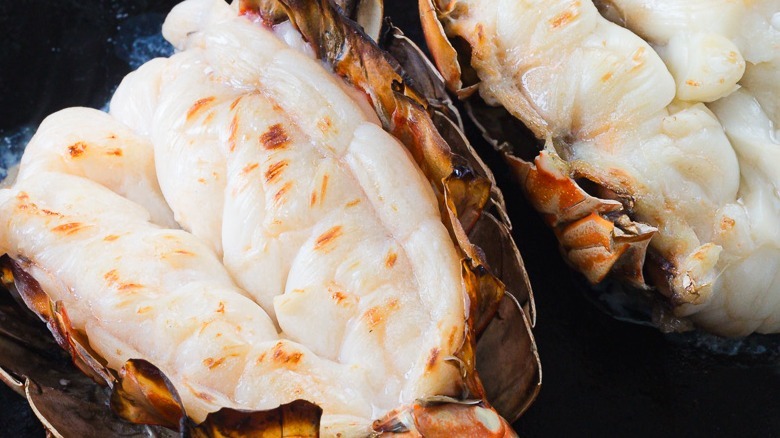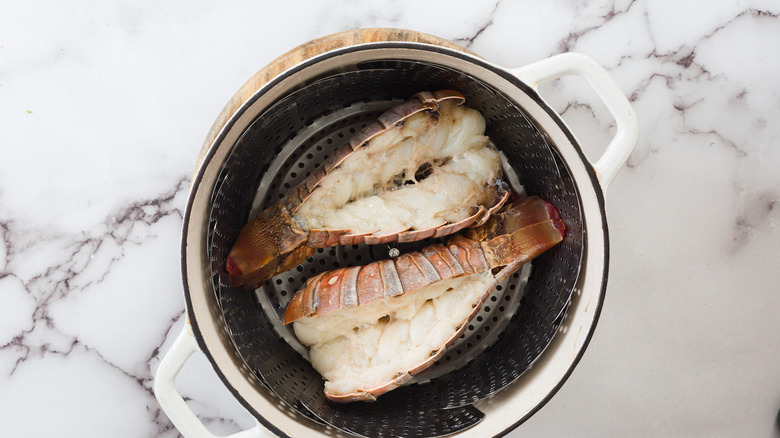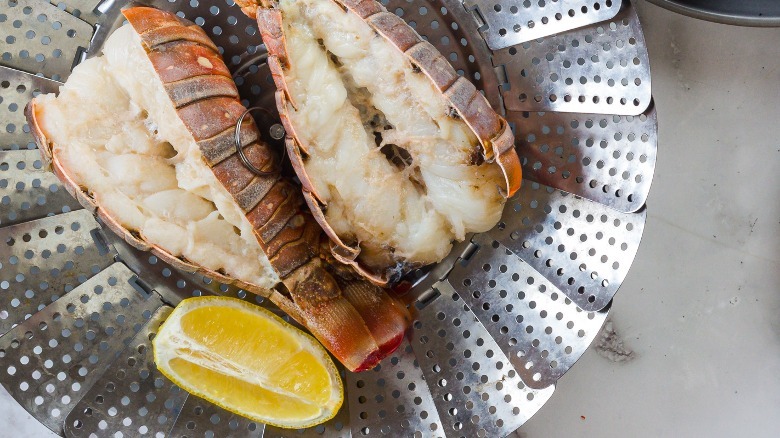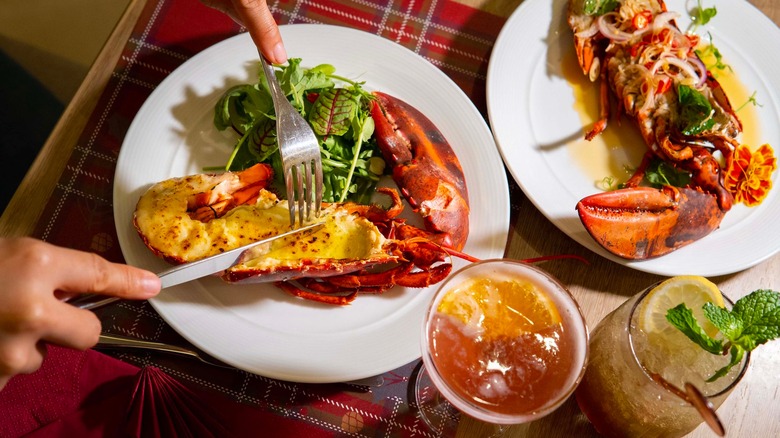How To Butterfly And Cook A Lobster Tail
Cooking lobster tail for the first time can feel intimidating, but it truly doesn't have to be. There are few proteins in the world that taste as subtle, unique and succulent as a lobster, and getting to the meat of the matter is all about mastering a few simple steps.
Lobster tails are, as you may have guessed, the posterior section of a lobster, extending from the end of the lobster's thorax to its tail fan. They are a popular seafood delicacy due to their sweet, tender meat and relatively easy preparation. Simply put, this is the meatiest part of the lobster, and the most rewarding way to eat it without having to worry about green stuff, cutting through sharp claws, or wasting too much lobster meat. One of the most common preparations of lobster tail is called butterflying, a term that hints at what the final result looks like.
Butterflying lobster tails not only makes them look impressive, but also ensures even cooking and easy eating. In this guide, we'll explore how to butterfly and cook lobster tails using our three favorite methods: grilling, broiling in the oven, and steaming. While we focus on these three methods, other ways to prepare lobster tails include pan-searing, poaching, and sous vide cooking. By mastering these techniques, you'll be able to create restaurant-quality lobster tail dishes at home, impressing guests with your easy charm and kitchen prowess. Move over, Martha Stewart — there's a new lobster cook in town.
What is butterflying a lobster tail?
If you search for images of butterflied lobster tails, most photos will actually steer you in the wrong direction, towards what is known as piggybacking a lobster tail. Worry not, friends, for we're about to explain the difference.
Butterflying a lobster tail involves cutting the top shell of the tail lengthwise down the middle, stopping at the base, and then spreading the meat open to give the crustacean a butterfly-like look. This method is our favorite because it makes the meat easy to reach and helps it cook uniformly.
Piggybacking, on the other hand, involves cutting the top of the shell lengthwise and separating the meat from the bottom shell, but instead of cutting it in half and lifting it entirely out, the meat remains partially attached at the base. The lobster meat is then pulled up and over the shell, resting on top of it while remaining connected at the tail end. This creates a layered look, with the meat "riding" on top of the shell, hence the term "piggybacking."
Generally, butterflying looks a bit more dramatic than piggybacking, but the increased surface area allows the lobster meat to cook more evenly. It's also the best technique for grilling, which is our favorite way to cook lobster tail and the first one we'll tackle in a bit. But now that we've gotten those terms (and potential confusion) out of the way, let's break down the steps needed to butterfly a lobster tail.
Step 1: Thaw your lobster tails
First, if frozen, remove lobster tails from the freezer and thaw in the fridge.
Step 2: Remove swimmerets
Remove the swimmerets, which are the lobster's little legs that look like fins, from the underside of the tail. We recommend a pair of kitchen shears for this task.
Step 3: Cut through top shell
Using kitchen shears, cut through the top shell all along to the tail fin, leaving the bottom shell intact.
Step 4: Cut through the meat
With a chef's knife, cut through the meat along the same line, stopping before you cut through the bottom shell.
Step 5: Open the lobster
Using your hands, gently open the lobster shell like a book, hinging at the center.
Step 6: Rinse the lobster
Once the lobster tails are fully butterflied, rinse them under cold water to remove debris and intestinal veins.
Method 1: Grilling
To grill butterflied lobster tails, start by preheating your grill to medium heat. Once the grill is hot, place the lobster tails meat-side down directly on the grates.
Sear the meat for approximately 2 minutes, allowing it to develop a slight char and absorb the smoky flavor from the grill. After searing, flip the tails so they're resting on their shells.
At this point, you need to top the exposed meat with butter. Our preference is for butter mixed with herbs, which is done by simply mixing half a cup of salted butter with about 4 tablespoons of the mixed herbs of your choice. Popular choices are thyme, chives, tarragon and minced parsley.
Continue cooking the lobster tails for about 5 minutes without flipping them again. The lobster tails are done when the meat is opaque and firm to the touch, with an internal temperature of 140 F.
Method 2: Broiling
Broiling lobster tails is convenient because it gives the meat a similar preparation to a grill, but it brings it into the oven and the comfort of your home. To broil butterflied lobster tails, begin by preheating your oven's broiler to high.
Once hot, position the oven rack so that the lobster tails will be 4-6 inches away from the heat source. Place the prepared lobster tails on a large oven-safe pan or a baking sheet, meat side up. Slide the baking sheet into the oven under the broiler.
Cook the lobster tails for 5-7 minutes, keeping a close eye on them to prevent burning. The tails are done when the meat turns opaque and is firm to the touch, and the internal temperature measures 140 F. You can brush the meat with melted butter halfway through cooking for added flavor and moisture, but this isn't strictly necessary.
Method 3: Steaming
Steaming lobster tails is probably the most underrated method, because it sounds boring but it actually yields the juiciest meat. To steam butterflied lobster tails, start by filling the bottom of a steamer pot with about an inch of water and bring it to a boil over high heat. Once the water is boiling, place the prepared lobster tails shell side down in the steamer basket. Carefully lower the steamer basket into the pot, cover with a tight-fitting lid, and reduce the heat to medium.
Steam the lobster tails for 5-6 minutes, until, as with other methods, the meat turns opaque and the internal temperature measures 140 F. Try to avoid lifting the lid during the cooking process to peek in on the lobster, because this will cause the heat to escape and the lobster will need to cook longer.
What to serve with lobster tail?
Lobster tail is its own cause for a celebration, but you don't have to accompany it with much to do it justice. Serve lobster tail with a glass of white wine, a wedge of lemon and some melted butter on the side. With something this simply delicious, a straightforward preparation will never do you wrong.
If you're feeling fancy, though, you can go beyond butter and serve lobster with hollandaise sauce or kewpie mayo for a zesty, creamy kick. And on the off-chance you have any lobster tail meat left over, use it the next day to make classic lobster Newburg or a rich and creamy lobster bisque.
